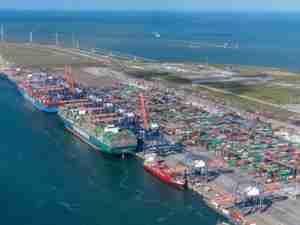The new vehicles have a load capacity of 61 tons, and can carry cassettes with double-stacked 40-foot containers or two 20-foot containers in a single tier. Major improvements to manoeuvrability have been made by incorporating individual electrically driven and steered bogie axles which enable the C-AGVs to be moved in any direction and turn through 360 degrees. This increases the versatility and flexibility of the AGV while minimising congestion at the quayside.
“As the use of AGVs in container terminals has become more widespread, so has awareness of the limitations of traditional AGVs,” says Michel Lyrstrand of TTS Port Equipment AB. “The C-AGV can be steered conventionally or ‘crab’ diagonally, or it can move completely transversally. New cassette designs enable the C-AGV to enter and exit both transversally and longitudinally, which allows decoupling at the quayside that is the key to the system’s cargo handling efficiency.”
The C-AGV offers several key benefits. It is easier to decouple under the quay crane – a function that is seen as a primary requirement in the terminal operating industry. The pattern of cassette lanes and highways combined with the vehicle’s manoeuvrability means that a much higher number of quay cranes can be served more easily compared to other solutions, without losing capacity due to congestion at the quayside. The versatility of the C-AGV also helps to improve the productivity of stacking cranes – both for stacks orientated perpendicular and parallel to the quay.
TTS has developed the C-AGV range in cooperation with the Swiss technology company Numexia SA, which has pioneered the energy-efficient, contactless energy transfer chain using coils embedded in the top layer of the roadway surface. This system enables the C-AGV to meet the zero emission requirements. Danaher Motion Särö AB, an industry leader in motion control technology, provided the advanced navigation control and traffic management system designed for the new mobility pattern.










